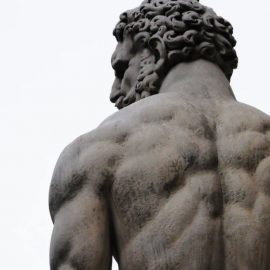

This article is an excerpt from the Shortform book guide to "Stamped from the Beginning" by Ibram X. Kendi. Shortform has the world's best summaries and analyses of books you should be reading.
Like this article? Sign up for a free trial here.
What is “uplift suasion”? What is the problem with trying to challenge racism by way of persuasion?
Uplift suasion is a way of addressing racism that is premised on disproving the stereotypes associated with Black people. Although uplift suasion is meant to combat racism, it does precisely the opposite: it perpetuates racist ideas by imposing the white standard.
Here’s why the logic behind uplift suasion is inherently racist, according to Ibram X. Kendi.
“Uplift Suasion” and the “Extraordinary Negro”
While abolitionist arguments in America date back to the late 1600s, opposition to slavery gathered momentum through the 18th century, culminating in the gradual passage (from 1780-1804) of antislavery laws in Northern states. Kendi says that one of the main approaches in this early abolitionist movement was to demonstrate that Black people were (or could be) equal to their white counterparts. Kendi calls this approach uplift suasion—the idea that if Black people prove their intellectual, moral, or other capabilities, white people will realize that their racist ideas are wrong.
Unfortunately, Kendi says, this tactic was doomed from the beginning. For one thing, as we’ve seen, slavery existed not because enslavers believed in racist ideas, but because they benefited from slavery. Therefore, even if you discredited the ideas, the benefit remained and so would the institution.
| You Can’t Persuade Away Racist Ideas The logic of uplift suasion is similar to another kind of persuasion-based antiracism strategy called “education suasion.” In How to Be an Antiracist, Kendi explains that education suasion assumes that shite people are racist because they don’t know any better. By this theory, you can eliminate racism by teaching white people not to be racist—for example, by pointing to examples of high-achieving Black people, or by explaining how racist policies harm people. According to Kendi, the problem with both uplift suasion and education suasion is that nothing can persuade away racist ideas. First, as we’ve seen, Kendi believes that racism doesn’t come from ignorance, but from racist policies. As a result, educating the average white person (who has no say over those policies) won’t accomplish anything. He also points out that racist policy makers are likely already aware of the effects of their policies, meaning that there’s nothing to educate them about. Moreover, even if education had a chance of working, it can be difficult to get people to recognize and confront their own biases. As Robin DiAngelo argues in White Fragility, some white people react defensively to even the suggestion that they might be racist—a fact that makes it hard to even have conversations about race and racism. |
Additionally, it was easy for racists to ignore evidence that contradicted their ideas. Kendi points out that when confronted with well-educated, articulate, and literate Black people, such as Cambridge-educated Francis Williams and published poet Phillis Wheatley, white racists dismissed them as “extraordinary negroes” who were exceptions to the general rule of Black inferiority.
(Shortform note: The “extraordinary negro” idea is still around today. For example, Kendi points out that in 2007, then-Senator Joe Biden described Barack Obama as “the first mainstream African-American who is articulate and bright and clean and a nice-looking guy.” Meanwhile, other commentators at the time debated whether a “good Black” like Obama was “Black enough” to appeal to fellow Black voters—and more recently, similar debates have arisen about Vice President Kamala Harris. There are two problems with this line of thought. First, it implies that all Black people are a certain way, and second, it implies that successful Black people don’t fit a standard Black “mold” (that is, they are extraordinary exceptions).)
Moreover, Kendi says, the basic logic of uplift is inherently racist. By suggesting that Black people can prove their worth by achieving white standards of intelligence, learning, culture, and so on, uplift implies that white standards are the superior standards to which all races should aspire (in the process dismissing any culture other than that of post-Enlightenment Western Europe).
(Shortform note: In White Fragility, Robin DiAngelo argues that these default white standards even pervade our language. She points out that we frequently use terms like “African American,” “Asian American,” “Latino American,” and so on, but rarely say things like “white American” or “Caucasian American.” She argues that this is because as a society, we see whiteness as the default form of American citizenship and identity.)
Plus, Kendi points out, uplift shifts the blame for racial disparities onto Black people. If some Black people can “better” themselves by adopting white ideals, the implication is that “lesser” Black people have only themselves to blame for their situations and for racism itself. If only Black people as a whole behaved better, the logic goes, people would view and treat them better.
(Shortform note: Another possible reason the uplift approach is ineffective is that people can struggle to differentiate between members of other races. In Biased, Jennifer Eberhardt argues that our brains’ preference for simplicity causes us to reduce groups other than our own to broad categories—a phenomenon she calls the “other-race effect.” The other-race effect explains why people sometimes proclaim that members of another racial group “all look alike”—and it may explain why white racists saw people like Williams and Wheatley as exceptions to the larger Black category rather than as evidence that disproved their racist preconceptions.)

———End of Preview———
Like what you just read? Read the rest of the world's best book summary and analysis of Ibram X. Kendi's "Stamped from the Beginning" at Shortform.
Here's what you'll find in our full Stamped from the Beginning summary:
- How enslavers convinced themselves that slavery benefited slaves
- Why most antiracist reformers harbored racist thoughts
- How to achieve an antiracist society






